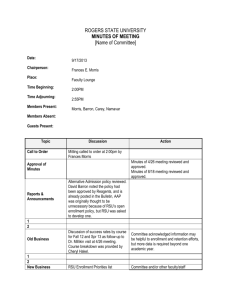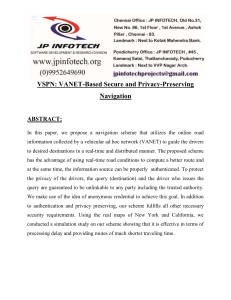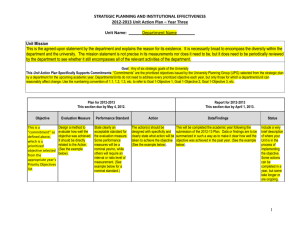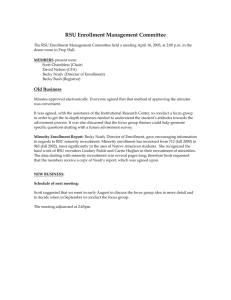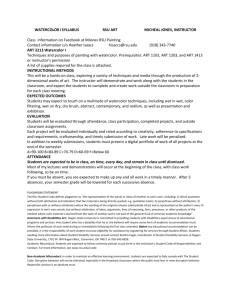Research Journal of Applied Sciences, Engineering and Technology 8(13): 1607-1612,... ISSN: 2040-7459; e-ISSN: 2040-7467
advertisement
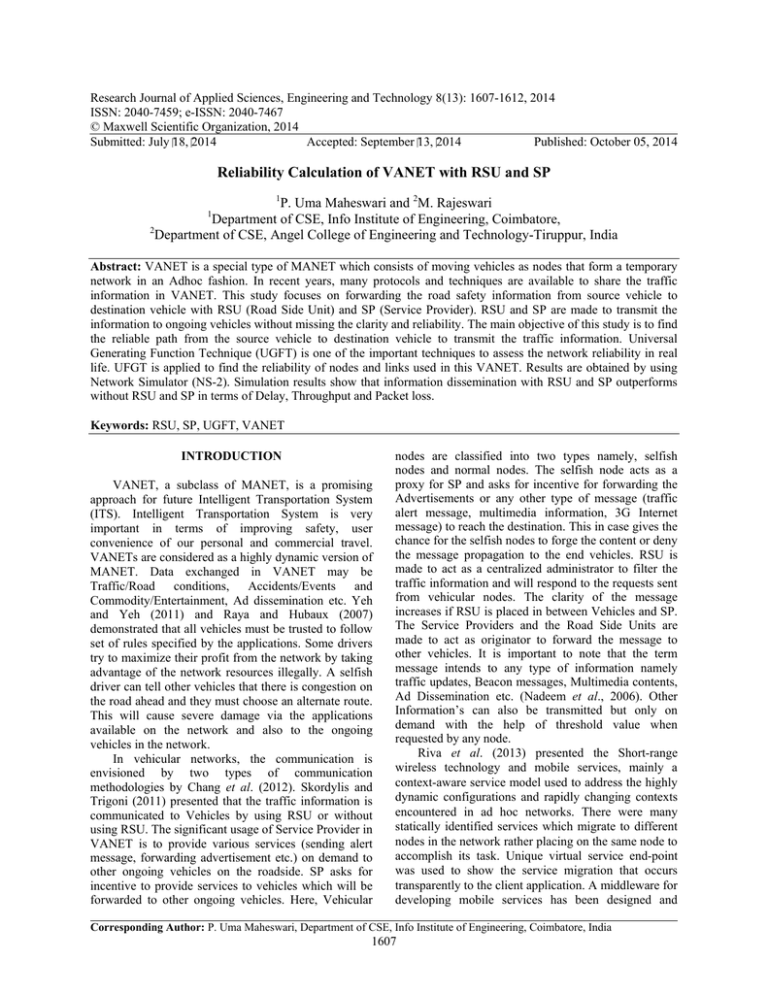
Research Journal of Applied Sciences, Engineering and Technology 8(13): 1607-1612, 2014 ISSN: 2040-7459; e-ISSN: 2040-7467 © Maxwell Scientific Organization, 2014 Submitted: July 18, 2014 Accepted: September 13, 2014 Published: October 05, 2014 Reliability Calculation of VANET with RSU and SP 1 P. Uma Maheswari and 2M. Rajeswari Department of CSE, Info Institute of Engineering, Coimbatore, 2 Department of CSE, Angel College of Engineering and Technology-Tiruppur, India 1 Abstract: VANET is a special type of MANET which consists of moving vehicles as nodes that form a temporary network in an Adhoc fashion. In recent years, many protocols and techniques are available to share the traffic information in VANET. This study focuses on forwarding the road safety information from source vehicle to destination vehicle with RSU (Road Side Unit) and SP (Service Provider). RSU and SP are made to transmit the information to ongoing vehicles without missing the clarity and reliability. The main objective of this study is to find the reliable path from the source vehicle to destination vehicle to transmit the traffic information. Universal Generating Function Technique (UGFT) is one of the important techniques to assess the network reliability in real life. UFGT is applied to find the reliability of nodes and links used in this VANET. Results are obtained by using Network Simulator (NS-2). Simulation results show that information dissemination with RSU and SP outperforms without RSU and SP in terms of Delay, Throughput and Packet loss. Keywords: RSU, SP, UGFT, VANET INTRODUCTION VANET, a subclass of MANET, is a promising approach for future Intelligent Transportation System (ITS). Intelligent Transportation System is very important in terms of improving safety, user convenience of our personal and commercial travel. VANETs are considered as a highly dynamic version of MANET. Data exchanged in VANET may be Traffic/Road conditions, Accidents/Events and Commodity/Entertainment, Ad dissemination etc. Yeh and Yeh (2011) and Raya and Hubaux (2007) demonstrated that all vehicles must be trusted to follow set of rules specified by the applications. Some drivers try to maximize their profit from the network by taking advantage of the network resources illegally. A selfish driver can tell other vehicles that there is congestion on the road ahead and they must choose an alternate route. This will cause severe damage via the applications available on the network and also to the ongoing vehicles in the network. In vehicular networks, the communication is envisioned by two types of communication methodologies by Chang et al. (2012). Skordylis and Trigoni (2011) presented that the traffic information is communicated to Vehicles by using RSU or without using RSU. The significant usage of Service Provider in VANET is to provide various services (sending alert message, forwarding advertisement etc.) on demand to other ongoing vehicles on the roadside. SP asks for incentive to provide services to vehicles which will be forwarded to other ongoing vehicles. Here, Vehicular nodes are classified into two types namely, selfish nodes and normal nodes. The selfish node acts as a proxy for SP and asks for incentive for forwarding the Advertisements or any other type of message (traffic alert message, multimedia information, 3G Internet message) to reach the destination. This in case gives the chance for the selfish nodes to forge the content or deny the message propagation to the end vehicles. RSU is made to act as a centralized administrator to filter the traffic information and will respond to the requests sent from vehicular nodes. The clarity of the message increases if RSU is placed in between Vehicles and SP. The Service Providers and the Road Side Units are made to act as originator to forward the message to other vehicles. It is important to note that the term message intends to any type of information namely traffic updates, Beacon messages, Multimedia contents, Ad Dissemination etc. (Nadeem et al., 2006). Other Information’s can also be transmitted but only on demand with the help of threshold value when requested by any node. Riva et al. (2013) presented the Short-range wireless technology and mobile services, mainly a context-aware service model used to address the highly dynamic configurations and rapidly changing contexts encountered in ad hoc networks. There were many statically identified services which migrate to different nodes in the network rather placing on the same node to accomplish its task. Unique virtual service end-point was used to show the service migration that occurs transparently to the client application. A middleware for developing mobile services has been designed and Corresponding Author: P. Uma Maheswari, Department of CSE, Info Institute of Engineering, Coimbatore, India 1607 Res. J. Appl. Sci. Eng. Technol., 8(13): 1607-1612, 2014 implemented. A proof-of-concept method helps mobile services to dynamically compute the average vehicular speed in a region ahead of a given car by using only car-to-car short-range wireless communication. Handorean et al. (2012) demonstrated that the increasing ubiquity of wireless mobile devices is promoting unprecedented levels of electronic collaboration among devices interoperating to achieve a common goal. However, certain technical concerns relating to reliable interactions among hosts in ad hoc networks have not yet received much attention. Malandrino et al. (2013) explained that the Communication enabled vehicles are interested in downloading different contents from Internet based servers. Vehicular communication is envisioned to enable News reporting, Navigation maps, Software updating and Multimedia files downloading. In order to transmit the message efficiently, the downloading process is considered to be an optimization problem. Terroso-Saenz et al. (2012) proposed a cooperative approach to traffic congestion detection with complex event processing in VANET. Li et al. (2013) have proposed three algorithms for message dissemination in VANET. The three algorithms are Distance Based Gradient algorithm, Privacy Preserving and Incentive Centered Cash-in algorithm. An Incentive-Centered architecture is proposed to encourage the SPs to set reasonable cost and effect requirements for ad dissemination. A novel Distance-Based Gradient (DBG) algorithm is proposed to disseminate ads to emulate the ad posting patterns in the physical world and control the cost and effect of ad dissemination. MATERIALS AND METHODS Li et al. (2013), have explained message dissemination in VANET by using 3 different algorithms. This study introduces UGF technique in addition to the algorithms used in the existing work to improve the reliability of VANET. The Service Provider (SP) and the Road Side Unit (RSU) are made to act as authorities for vehicles to disseminate the messages. The Service Provider disseminates the message to RSU which, in turn disseminates to other ongoing vehicles on the road side. For example, six vehicles, RSU and SP are grouped to form a cluster. Each and every vehicle acts as a source to increase the clarity of the message, until the message reaches the destination, so that the gradient and the clarity of the message do not get affected. The messages like traffic warning and safety/liability messages are transmitted from RSU to Vehicles. Vehicles are allowed to act as an originator to disseminate the messages to RSU and to other vehicles on the road side if any emergency situation arises. The Service provider has to pay the incentives for the vehicles through the RSU for transferring the advertisements about the organization Fig. 1: Transmission connectivity between vehicles via SP and RSU or an entity. The vehicles can also download the internet content messages like 3G, Multimedia, E-mail, MP3, etc from the RSU. The RSU will ask for incentives from the vehicles to transfer the necessary content appropriately as requested by the vehicles. The RSU will reply effectively by sending the messages only to the destined vehicles after paying the incentives. Here all the incentives transferred and received will be stored in RSU in the form of electronic cash. Figure 1 represents the transmission connectivity between set of vehicles for transferring traffic information from source node (SR) to target node (TR) via SP and RSU. It is assumed that six vehicles in a particular area form a temporary network where node 1 is considered to be the source node and node 6 is treated as the target node. Node 1 in the VANET wants to send a traffic message to the target node 6 through intermediate vehicles. SP will maintain all types of messages like ad dissemination, multimedia content, traffic alert message and other warning messages. It will not forward all the information unless a node requests. Request is made by a vehicle by using RSU which, in turn responds to the request accordingly. RSU is capable of verifying the information and the nature of the message whether it is a high priority message or not and also it is possible to find whether a vehicular node is a selfish node or a non-selfish node. RSU collects the messages from SP and store it in the queue which is situated inside the RSU. Traffic messages by default are transferred to all the ongoing vehicles on the road side, because they are highly reliable and secure. The RSU is capable of sending the messages to the vehicles with the help of the Service Provider based on the request provided by the vehicle. Here the Reliability is 1608 Res. J. Appl. Sci. Eng. Technol., 8(13): 1607-1612, 2014 calculated from source node to target node by using UGF (Universal Generating Function). From source node 1 to target node 6, different possibilities are identified by using UGFT and then the final VANET reliability is achieved. Next section describes the proposed UGFT to calculate the reliability. Reliability calculation: Reliability is one of the promising techniques of ensuring the working condition of a system. In VANETs, the information is passed by a flow of transition from any node to any other node to reach the required destination. For a successful packet delivery, reliable routes are necessary. In order to analyze the link reliability, a link UGF is proposed by combining the node UGF. UGFT is used to calculate the proposed VANET reliability by using node reliability and link reliability. UGF plays an important role in finding out the expected capacity for each transmitting path involved in the VANET and also in the evaluation of link reliability. The first UGFT was proposed by Ushakov (1986) for the one-to-many targets acyclic Multi Information Network (MIN) reliability problem and explored by Levitin (2005) and Lisnianski and Levitin (2003) and was improved by Yeh using some simplified techniques (Yeh, 2006). Malinowski and Preuss (1996) and Yeh and Yeh (2011) have demonstrated that the UGFT was proven to be very effective for evaluating the reliability of different types of Acyclic Multistate Networks, especially for the MIN. UGFT is used for reliability calculation of MIN, Multi State System (MSS), Binary State Network (BSN) and Acyclic Binary State Network (ABSN) Yeh (2009), Yeh and He (2010) and Meena and Vasanthi (2012) in addition to Acyclic Multistate Network. The objective of this study is to provide an efficient, effective technique to manipulate the VANET reliability. The reliability of VANET is defined as the successful transmission of information from source node to target node by identifying different possibilities. Table 1: Connectivity of nodes and their probabilities Connectivity SR-i (any node) 2-3 2-4 2-5 3-4 3-5 4-5 i-TR SP-RSU SDP 1 0.5 0.6 0.4 0.8 0.7 0.3 0.2 1 Illustration: Connectivity between set of vehicles and RSU/between SP and RSU and their SDPs (State Dependent Probability) are illustrated in the following Table 1. Reliability is calculated by using Source node UGF and Member node UGF. The link reliability of a VANET can be calculated as follows: First possibility: = = P 1:2,3,4,5:6 +P 1:2,3,5,4:6 +P 1:2,4,5,3:6 +P 1:2,4,3,5:6 + P 1:2,5,3,4:6 +P 1:2,5,4,3:6 1 x 0.5 x 0.8 x 0.3 x 0.2 +1 x 0.5 x 0.7 x 0.3 x 0.2+1 x 0.6 x 0.3 x 0.7 x 0.2+1 x 0.6 x 0.8 x 0.7 x 0.2+1x 0.4 x 0.7 x 0.8 x 0.2+1 x 0.4 x0.3 x 0.8 x 0.2 = 0.024+0.021+0.025+ 0.067+0.045+ 0.019 = 0.201. Second possibility: = = P 1:3,2,4,5:6 +P 1:3,2,5,4:6 +P 1:3,4,2,5:6 + P 1:3,4,5,2:6 +P 1:3,5,2,4:6 +P 1:3,5,4,2:6 1 x 0.5 x 0.6 x 0.3 x 0.2 +1 x 0.5 x 0.4 x 0.3 x 0.2+1 x 0.8 x 0.6 x 0.4 x 0.2+1 x 0.8 x 0.3 x 0.4 x 0.2+1x 0.7 x 0.4 x 0.6 x 0.2+1 x 0.7 x0.3 x 0.6 x 0.2 = 0.018+0.012+0.038+0.019+ 0.034 + 0.025 = 0.146. Third possibility: Definition 1: The source node UGF is defined as the probability of receiving the message from RSU such that u ( S ) = PRSU :S X S . = = Definition 2: The UGF of member nodes of a cluster is defined as u ( i ) = n ∏ i =1 Pi ,i +1,i + 2...n X n , if there are n nodes in a cluster. Here Pi ,i +1,i + 2...n represents the probability of sending the information from node i to its next node till it reaches the target node. Definition 3: Reliability of the cluster is defined as the probability of disseminating the information from source node to target node through n number of nodes and is given by Rcl = u ( S ) * u (i ) where i = 1, 2, P 1:4,2,3,5:6 +P 1:4,2,5,3:6 +P 1:4,5,2,3:6 + P 1:4,5,3,2:6 +P 1:4,3,5,2:6 +P 1:4,3,2,5:6 1 x 0.6 x 0.5 x 0.7 x 0.2 +1 x 0.6 x 0.4 x 0.7 x 0.2+1 x 0.3 x 0.4 x 0.5 x 0.2+1 x 0.3 x 0.7 x 0.5 x 0.2+1x 0.8 x 0.7 x 0.4 x 0.2+1 x 0.8 x0.5 x 0.4 x 0.2 = 0.042+0.034+0.012+0.021+ 0.045+ 0.032 = 0.186. Fourth possibility: = = ∑ i 3…n. 1609 P 1:5,2,3,4:6 +P 1:5,2,4,3:6 +P 1:5,3,4,2:6 + P 1:5,3,2,4:6 +P 1:5,4,2,3:6 +P 1:5,4,3,2:6 1 x 0.4 x 0.5 x 0.8 x 0.2+ 1 x 0.4 x 0.6 x 0.8 x 0.2+1 x 0.7 x 0.8 x 0.6 x 0.2+1 x 0.7 x 0.5 x 0.6 x 0.2+1 x 0.3 x 0.6 x 0.5 x 0.2+1 x 0.3 x0.8 x 0.5 x 0.2 = 0.032+0.038+0.067+0.042+0.018 + 0.024 = 0.221. Res. J. Appl. Sci. Eng. Technol., 8(13): 1607-1612, 2014 Reliability of VANET is defined by integrating the reliabilities all the possibilities: = 0.201+0.146+0.186+0.221 = 0.754 = 0.8 RESULTS AND DISCUSSION The delay ratio is calculated based on the node velocity (Distance in Meter) vs. the end-end delay in percentage. The Service Provider along with the RSU outperforms by producing the minimum delay. When comparing with the above without the Service Provider, the messages are transmitted in random and 30 Without SP With SP and RSU End-end delay (%) 25 20 15 10 5 0 2 1 3 4 5 Node velocity in m/s 6 7 comparatively leads to more loss. Hence the SP along with the RSU provides less delay while transferring packets to the destination with high velocity. Figure 2 illustrates the delay variation in the presence of SP and RSU and without the presence of SP. The delivery ratio is calculated based on the node velocity (Distance in Meter) vs. the packet delivery ratio in percentage. Figure 3 denotes the Packet Delivery of proposed scheme. The Service Provider along with the RSU outperforms by producing the Maximum delivery ratio i.e., the total number of packets are delivered more if we use SP and RSU. Number of packets that are delivered gets reduced when RSU is not deployed. The Service Provider will disseminate the messages only to the authorized vehicles through RSU. Hence it produces comparatively highest speed and delivery ratio while transferring packets to the destination with high velocity. But the RSU cannot deliver the advertisements to the vehicles without knowing the appropriate Service Provider. The Throughput is calculated based on the node velocity (Distance in Meter) vs. the throughput in (KB/s) which is illustrated in Fig. 4. The Service Provider along with the RSU performs better by producing the Maximum throughput ratio. The Service Provider will increase the throughput by sending the Fig. 2: Delay Without SP With SP and RSU 50 Delivery ratio (%) Number of packets drop (%) 20 60 40 30 20 10 Without SP With SP and RSU 15 10 5 0 1 0 2 1 3 4 5 Node velocity in m/s 6 3 2 7 4 5 6 7 Node velocity in m/s 9 8 Fig. 5: Packet loss Fig. 3: Packet delivery ratio 70 16 Without SP With SP and RSU Energy rati o (%) Throughput in Kb/s 14 Without SP With SP and RSU 60 12 10 8 6 4 50 40 30 20 10 2 0 0 1 Fig. 4: Throughput 2 3 4 5 Node velocity in m/s 6 1 7 2 4 5 3 Node velocity in m/s Fig. 6: Energy consumption 1610 6 Res. J. Appl. Sci. Eng. Technol., 8(13): 1607-1612, 2014 messages only to the destined vehicles. Comparatively highest throughput will be obtained while transferring packets to the destination with high velocity when comparing with the message dissemination without using the SP because here the RSU does not know the Service Provider for sending the advertisements. The Packet Loss is calculated based on the node velocity (Distance in Meter) vs. the number of the packets dropped. The Service provider along with the RSU reduces the packet loss when the message is transferred from the source node to the target node by calculating the reliability using UGFT. The messages will reach the destination from SP to the vehicles through RSU. Hence the packet loss can be easily identified since the SP maintains the vehicle identity. Packet Loss will be more without the presence of RSU and SP. This is illustrated in Fig. 5. The Energy consumption ratio is calculated based on the node velocity (Distance in Meter) vs. the Energy Ratio. The Service provider along with the RSU outperforms by consuming only the minimum energy for transferring the messages to reach the destination. The SP and RSU will make each and every vehicle to act as a source to reach the destination. Hence it takes only less energy and improves the clarity and gradient of message for transferring packets to the destination with high velocity. Figure 6 depicts the Energy Rate with SP and RSU and without SP. Simulation results show that message reliability and clarity is achieved by adapting SP and RSU in VANET. CONCLUSION REFERENCES Chang, J.J., Y.H. Li, W. Liao and I.C. Chang, 2012. Intersection based routing for urban vehicular communications with traffic-light considerations. IEEE Wirel. Commun., 19(1): 82-88. Handorean, R., R. Sen, G. Hackmann and G.C. Roman, 2012. Context aware session management for services in ad hoc networks. Department of Computer Science, Washington University, USA. Levitin, G., 2005. Universal Generating Function in Reliability Analysis and Optimization. SpringerVerlag, London, pp: 442. Li, Z., C. Liu and C. Chigan, 2013. On secure vanetbased ad dissemination with pragmatic cost and effect control. IEEE T. Intell. Transp., 14(1): 124-135. Lisnianski, A. and G. Levitin, 2003. Multi-state System Reliability, Assessment, Optimization and Applications. World Scientific, New York. Malandrino, F., C. Casetti, C. Chiasserini and M. Flore, 2013. Optimal content downloading in vehicular networks. IEEE T. Mobile Comput., 12(7): 1377-1391. Malinowski, J. and W. Preuss, 1996. Reliability evaluation for tree structured systems with multistate components. Microelectron. Reliab., 36(1): 9-17. Meena, K.S. and T. Vasanthi, 2012. Reliability evaluation of a flow network through m number of minimal paths with time and cost. Eur. J. Sci. Res., Vol. 5. Nadeem, T., P. Shankar and L. Iftode, 2006. A comparative study of data dissemination models for VANETs. Proceeding of 3rd ACM/IEEE International Conference on Mobile Ubiquitous System Networks Serv., pp: 1-10. Raya, M. and J.P. Hubaux, 2007. Securing vehicular ad hoc networks. J. Comput. Secur., 15: 39-68. Riva, O., T. Nadeem, C. Borcea and L. Iftode, 2013. Mobile services: Context-aware service migration in ad hoc networks. IEEE T. Intell. Transp., 13(2). Skordylis, A. and N. Trigoni, 2011. Efficient data propagation in traffic monitoring vehicular networks. IEEE T. Intell. Transp., 12(3): 680-694. Terroso-Saenz, F., M. Valdes-Vela, C. SotomayorMartinez and R. Toledo-Moreo, 2012. A cooperative approach to traffic congestion detection with complex event processing and VANET. IEEE T. Intell. Transp., 13(2): 914-929. Ushakov, I., 1986. Universal generating function. Sov. J. Comput. Syst. S+, 24(5): 118-129. Yeh, W.C., 2006. The K out of N acyclic multistate node networks reliability evaluation using the universal generating function method. Reliab. Eng. Syst. Safe., 91(7): 800-808. There are many possibilities to forward the road safety information from a source vehicle to target vehicle. We introduced SP and RSU to take the responsibility for disseminating the information to ongoing vehicles on the roadside. This study proposes the method to calculate the reliability by using UGF techniques. Cluster of vehicles are considered out of which a vehicle can request any type of service to the RSU. RSU maintains a queue of requests and then it forwards the request to SP which, in turn responds to the desired vehicle by transferring the information via the set of all vehicles present in a cluster. Here Ad’s are not forwarded unless it is requested by a node. UGFT is applied to calculate the reliability between every vehicle to every other vehicle. Source UGF, member nodes UGF in a cluster are defined with illustration. Simulation results show that proposed technique works better with minimum delay, less packet loss, maximum packet delivery and throughput. To the best of our knowledge, this is the first technique to apply UGFT in VANET to improve the reliability. 1611 Res. J. Appl. Sci. Eng. Technol., 8(13): 1607-1612, 2014 Yeh, W.C., 2009. A simple universal generating function method for estimating general multistatenode networks reliability. IIE Trans., 41(1): 311. Yeh, W.C. and X. He, 2010. A new universal generating function method for estimating the novel multi-resource multistate information network reliability. IEEE T. Reliab., 59(3): 528-538. Yeh, W.C. and Y.M. Yeh, 2011. A novel label universal generating function method for evaluating the one-to-all-subsets general multistate information network reliability. IEEE T. Reliab., 60(2): 470-477. 1612
